Table of Contents
Top 10 Most Fierce Dog Breeds 2023
- Pit Bull
- Rottweiler
- German Shepherd
- Doberman Pinscher
- Akita
- Boxer
- Belgian Malinois
- Staffordshire Bull Terrier
- Rhodesian Ridgeback
- Mastiff
When it comes to dogs, “fierce” can be a bit subjective and can refer to different things: it might be about a dog’s physical strength, its protective nature, or its aggression when not properly trained or socialized.
CHECK: Top 10 Best Friendly Dog Breeds 2023
Top 10 Most Fierce Dog Breeds 2023: Pit Bull
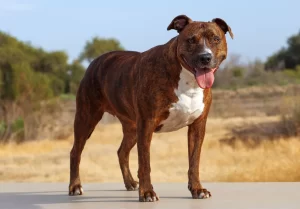

| Temperament | Exercise Needs | Training | Health | Lifespan | Potential Assertiveness |
|---|---|---|---|---|---|
| Strong-willed, Courageous, Affectionate | High | Moderate to difficult due to stubbornness | Prone to hip dysplasia, heart conditions | 12-14 years | High |
Pit Bulls are often recognized by their muscular build, short hair, and strong, square jawline. They are medium-sized dogs, usually weighing between 30 and 85 pounds.
History The origins of the Pit Bull can be traced back to the early 19th century in the United Kingdom when bulldogs and terriers were crossbred to create a dog that combined the strength of the bulldog with the agility and energy of the terrier. These dogs were often used in bull-baiting and later in dog fighting rings, which is where the “Pit” in Pit Bull comes from.
Temperament Despite the breed’s fighting origins, Pit Bulls are known to be affectionate, loyal, and deeply devoted to their families. They are also known for their courage and tenacity. Pit Bulls have a strong desire to please their people, which can make them excellent at obedience training. However, their energy and power require a responsible owner who can manage these traits appropriately.
Pit Bulls are often misunderstood and can sometimes be viewed as aggressive due to their powerful appearance and history. However, when raised with love, care, and proper training, Pit Bulls are generally friendly, gentle dogs that can get along well with children and adults.
Exercise and Training Pit Bulls are very active and energetic dogs that require plenty of exercise to stay healthy and happy. This can include daily walks, playtime in the yard, or structured activities like agility or obedience training.
Training a Pit Bull requires consistency, patience, and positive reinforcement. They can sometimes be stubborn, but their eagerness to please their owners usually makes them responsive to training. Socialization from a young age is also crucial to help them become well-rounded dogs.
Health and Lifespan Pit Bulls are generally healthy, but like all breeds, they can be prone to certain health conditions. This includes hip dysplasia, a common condition in many larger breeds, and heart conditions. With proper care and regular veterinary check-ups, these conditions can be managed effectively.
Top 10 Most Fierce Dog Breeds 2023: Rottweiler


| Temperament | Exercise Needs | Training | Health | Lifespan | Potential Assertiveness |
|---|---|---|---|---|---|
| Protective, Loyal, Confident | High | Moderate, responds well to consistent, firm training | Prone to hip dysplasia, heart conditions, eye diseases | 8-10 years | High |
The Rottweiler is a robust and powerful dog breed with a history that dates back to the Roman Empire. This breed is known for its protective nature, intelligence, and unwavering loyalty.
History The breed originated in Germany, specifically in the town of Rottweil, hence its name. Initially, Rottweilers were “drover dogs,” used to herd and guard livestock during the Roman Empire. They’ve also been utilized in various roles such as guide dogs for the blind, police dogs, search and rescue dogs, and even as pulling dogs to cart goods to market.
Temperament Rottweilers are naturally protective and tend to be reserved with strangers but are not aggressive without reason. When properly socialized, they are typically calm and confident, not prone to unnecessary aggression or excitement. They have a strong sense of their family, or “pack,” and can be quite affectionate and playful with family members.
Rottweilers are intelligent dogs and have a strong desire to work. They’re often happiest when they have a job to do, which makes them suited for roles such as search and rescue or obedience competitions.
Exercise and Training Rottweilers are an active and intelligent breed, requiring both physical and mental stimulation daily. Regular walks, play sessions, and even participation in canine sports like obedience or agility can be beneficial for this breed.
Training should start at an early age for Rottweilers and continue into adulthood. They respond best to firm, fair training methods and positive reinforcement. Their intelligence and desire to please their owners usually make them a breed that’s a joy to train. Proper socialization is also critical for this breed, exposing them to various environments, people, and other animals to ensure they grow up to be well-rounded dogs.
Health and Lifespan While generally a healthy breed, Rottweilers, like any breed, can be predisposed to certain health conditions. This includes hip and elbow dysplasia, certain heart conditions, and eye diseases. Regular vet checks and a balanced diet can help prevent these issues and ensure your Rottweiler lives a long, healthy life.
The typical lifespan for a Rottweiler is around 8-10 years, although many can live longer with proper care and attention to their health.
CHECK: Gunna’s Guard Faces Off Person Calling Him Rat
Top 10 Most Fierce Dog Breeds 2023: German Shepherd
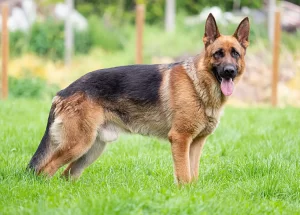

| Temperament | Exercise Needs | Training | Health | Lifespan | Potential Assertiveness |
|---|---|---|---|---|---|
| Intelligent, Loyal, Protective | High | Easy with consistent training | Prone to hip and elbow dysplasia, degenerative myelopathy | 7-10 years | High |
The German Shepherd Dog is a breed of working dog known for its intelligence and versatility as a police dog, guide and assistance dog, search and rescue dog, and military dog. These dogs are often large, powerful, and noble.
History The German Shepherd breed was established in Germany in the late 1800s, primarily by a military officer named Max von Stephanitz who admired the intelligence and working ability of German sheep-herding dogs. His goal was to standardize a breed of working dog that was highly intelligent and had a great working ability.
Temperament German Shepherds are known for their intelligence, loyalty, and versatility. These traits make them suitable for a variety of roles, from family pet to working dog roles, such as police and search and rescue work. They are protective of their family and are often aloof with strangers but should not be overly aggressive.
These dogs are eager learners and always up for a challenge, and they get on well with children. They’re also known for their high energy level, especially when they’re young.
Exercise and Training German Shepherds are active and fun-loving animals; they need lots of exercise daily. Regular walks, runs, and playtime can meet their needs. They also enjoy challenges, like learning tasks and playing with puzzle toys.
German Shepherds are highly trainable and eager to learn. Training should start at a young age and be consistent and positive. They respond well to rewards-based training and enjoy the mental stimulation that training provides. Socialization is also an important part of their training.
Health and Lifespan German Shepherds are generally healthy dogs, but they are prone to certain health problems. This includes hip and elbow dysplasia, degenerative myelopathy (a disease of the spinal cord), and certain heart conditions. Regular check-ups with the vet and a healthy diet can help prevent or manage these conditions.
The typical lifespan for a German Shepherd is around 7-10 years. However, many live longer with proper care and attention to their health.
Top 10 Most Fierce Dog Breeds 2023: Doberman Pinscher
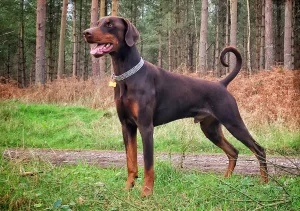

| Temperament | Exercise Needs | Training | Health | Lifespan | Potential Assertiveness |
|---|---|---|---|---|---|
| Loyal, Protective, Energetic | High | Easy to moderate, highly trainable | Prone to heart disease, hip dysplasia, Wobbler’s syndrome | 10-12 years | High |
The Doberman Pinscher, often just called a Doberman, is a breed of domestic dog originally developed around 1890 by Karl Friedrich Louis Dobermann, a tax collector from Germany. Dobermans are known for their loyalty, intelligence, and strong protective instincts.
History Louis Dobermann wanted to create a breed that was protective, intelligent, and loyal to assist him in his job as a tax collector. The exact breeds used to create the Doberman Pinscher are not known, but it’s thought that the Rottweiler, German Pinscher, Greyhound, and Weimaraner may have been involved.
Temperament Dobermans are known for their loyalty and are often considered one of the best guard dogs. They are protective of their families and can be reserved with strangers. They are typically non-aggressive towards their families and people they know but are assertive and can be aggressive towards perceived threats.
Dobermans are intelligent and quick learners. They have been used in many roles including police work, search and rescue, and as therapy dogs. Despite their tough exterior, they are often sensitive and need positive reinforcement during training.
Exercise and Training As an energetic and athletic breed, Dobermans require a good amount of daily exercise. This can include walks, runs, and playtime, as well as mentally stimulating activities like training exercises and puzzles.
Training a Doberman should start early and be consistent throughout their life. They respond well to positive reinforcement and need clear, firm, but kind guidance. Socialization is also important for Dobermans, as it helps them learn to be friendly and confident around unfamiliar people, animals, and environments.
Health and Lifespan Dobermans are generally healthy, but they can be prone to certain breed-specific conditions. This includes hip dysplasia, certain heart conditions, and von Willebrand’s disease, a bleeding disorder. Regular veterinary care, including check-ups and screenings, can help catch and manage these conditions early.
The average lifespan of a Doberman is around 10-12 years, but with proper care, many live longer.
Top 10 Most Fierce Dog Breeds 2023: Akita
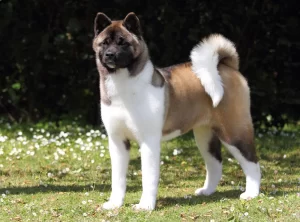

| Temperament | Exercise Needs | Training | Health | Lifespan | Potential Assertiveness |
|---|---|---|---|---|---|
| Reserved, Loyal, Protective | High | Moderate to difficult due to independence | Prone to hip dysplasia, autoimmune disorders, skin conditions | 10-15 years | Moderate |
The Akita is a large and powerful dog breed with a noble and intimidating presence. They were originally bred for guarding royalty and nobility in feudal Japan. The breed has been split into two varieties: the Akita Inu (Japanese Akita) and the Akita or American Akita.
History Akitas have a rich history in Japan and are considered a national treasure and a symbol of good health, happiness, and longevity. The Akita’s roots trace back to the 17th century, where they were used by the ruling class for hunting large game like boar, deer, and even bears.
Temperament Akitas are typically reserved, dignified, and profoundly loyal to their families. They can be aloof with strangers but affectionate with family members. They are known for their strong protective instincts. Akitas are quiet dogs and only bark when there is a good reason.
While they are generally good-natured and gentle with their families, they can sometimes show aggression towards other dogs, particularly those of the same sex. This makes early socialization a must for this breed.
Exercise and Training Akitas are powerful dogs with a lot of energy, and they require daily exercise to stay healthy and content. This could include walks, runs, or play sessions in a securely fenced area. They also enjoy activities that stimulate their minds, such as obedience training or interactive games.
Training an Akita can be a challenge due to their strong-willed nature. They respond best to positive reinforcement techniques and require a trainer who can provide firm but loving guidance.
Health and Lifespan While generally a healthy breed, Akitas can be prone to certain health issues like hip dysplasia, hypothyroidism, and Progressive Retinal Atrophy (PRA), which can cause vision loss. Regular veterinary check-ups can help identify and manage these issues early.
The average lifespan of an Akita is around 10-15 years. Good nutrition, regular exercise, and routine veterinary care can help ensure a long, healthy life.
Top 10 Most Fierce Dog Breeds 2023:
Boxer
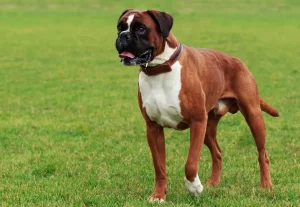

Boxer
| Temperament | Exercise Needs | Training | Health | Lifespan | Potential Assertiveness |
|---|---|---|---|---|---|
| Energetic, Fun-loving, Bright | High | Moderate, can be stubborn but responds well to positive reinforcement | Prone to heart conditions, cancer, hip dysplasia | 10-12 years | Moderate |
The Boxer is a breed of medium-to-large dogs developed in Germany. These dogs are widely known for their muscular build, short hair, and distinctive square muzzle. They are one of America’s most popular breeds.
History The Boxer’s ancestry goes back to a line of dogs throughout Europe in the 16th century, but the breed was perfected in the 19th century. The Boxer was developed by crossing the Bullenbeisser, a mastiff-type dog, with the Bulldog. The goal was to create a medium-sized hunting dog that could hold onto large, fierce prey.
Temperament Boxers are high-spirited, playful, and energetic. They are known for their love of family and bond closely with their owners. Boxers are also protective and have a strong instinct to guard their family and home. Despite their somewhat intimidating appearance, they are typically friendly with strangers but will stand their ground if they perceive a threat.
They’re great with children and can be protective playmates. However, because of their energy and strength, they might not be suitable for very young or frail individuals unless they are well-trained.
Exercise and Training Boxers are athletic dogs, and they need plenty of exercise. Regular walks, runs, and play sessions can meet their exercise needs. They also enjoy challenges, like learning tasks and playing with puzzle toys.
Training a Boxer should start at a young age as they can be stubborn at times but are also eager to please. They respond well to positive reinforcement techniques. Socialization is crucial for Boxers to ensure they grow up to be well-rounded dogs.
Health and Lifespan Boxers are generally healthy, but they can be prone to certain health problems. This includes hip dysplasia, heart conditions, and certain types of cancer. Regular vet visits and a healthy diet can help prevent or manage these conditions.
The average lifespan for a Boxer is around 10-12 years, but with proper care, many live longer.
Top 10 Most Fierce Dog Breeds 2023: Belgian Malinois
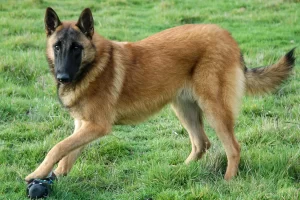

| Temperament | Exercise Needs | Training | Health | Lifespan | Potential Assertiveness |
|---|---|---|---|---|---|
| Alert, Hardworking, Protective | Very high | Easy, highly trainable | Prone to hip and elbow dysplasia, eye disorders | 14-16 years | High |
The Belgian Malinois is a medium-to-large breed of dog, one of the four types of Belgian sheepherding dogs. It is often mistaken for a German Shepherd due to their similar appearance, but the Malinois is typically smaller and has a more refined bone structure.
History The Belgian Malinois originated in the city of Malines, Belgium, where it was bred to herd and protect sheep. In recent years, this breed has seen a surge in popularity in many countries, especially the United States, due to its impressive abilities as a working dog. Today, Belgian Malinois are often used in police work, search and rescue, and military roles.
Temperament The Belgian Malinois is known for its protective instincts, intelligence, and high energy levels. These dogs are incredibly loyal to their families and are naturally protective, making them excellent guard dogs. However, they can be reserved or aloof with strangers.
Belgian Malinois are very trainable and have been known to excel in obedience, agility, and herding events. Their intelligence and eagerness to work make them suitable for many roles in service and working capacities.
Exercise and Training Belgian Malinois are very active and require a lot of exercise. They thrive when given a job to do, whether that’s herding, obedience training, or participating in dog sports. Without enough physical and mental stimulation, these dogs can become bored and potentially develop problematic behaviors.
Early and consistent training is crucial for Belgian Malinois. They are sensitive dogs and respond well to positive, reward-based training methods. Socialization is also very important for this breed, as it can prevent them from becoming overly suspicious or fearful of new things.
Health and Lifespan Belgian Malinois are generally a healthy breed, but they can be prone to certain health conditions such as hip and elbow dysplasia, progressive retinal atrophy, and certain types of cancer. Regular veterinary check-ups can help catch any potential health problems early.
The typical lifespan for a Belgian Malinois is around 12-14 years, but many live longer with proper care and attention to their health.
Top 10 Most Fierce Dog Breeds 2023: Staffordshire Bull Terrier
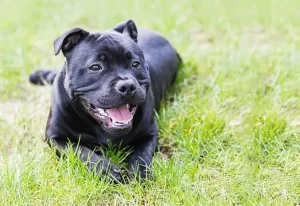

| Temperament | Exercise Needs | Training | Health | Lifespan | Potential Assertiveness |
|---|---|---|---|---|---|
| Affectionate, Courageous, Intelligent | High | Easy to moderate, responds well to positive reinforcement | Prone to hip dysplasia, eye problems, skin issues | 12-14 years | Moderate |
The Staffordshire Bull Terrier, affectionately known as the Staffie, is a medium-sized, short-coated breed of dog. It is of English lineage and is one of several breeds in the pit bull group.
History The Staffordshire Bull Terrier’s roots trace back to the 19th-century England where it was developed for bull-baiting and later used in dog fighting rings. However, after these sports were banned, breeders began focusing on refining the breed’s temperament, resulting in the affectionate and loyal Staffie known today.
Temperament Despite their muscular build and history as fighting dogs, Staffordshire Bull Terriers are known for their love of people and especially children, often referred to as a ‘nanny dog’. They are renowned for their affectionate nature, intelligence, and fearless courage.
Staffies are energetic and love playing games, especially with their families. They are generally friendly with strangers but will defend their families if needed. They can get along with other dogs but early socialization is key to prevent any possible aggression.
Exercise and Training Staffordshire Bull Terriers are an active and agile breed. They require regular exercise to keep them healthy and content. This can be achieved through walks, runs, or play sessions.
Training should start at a young age and be consistent. Staffies are eager to please and are generally quick to learn. They respond well to positive reinforcement training methods. Proper socialization is also important to ensure they grow up to be well-rounded dogs.
Health and Lifespan The Staffordshire Bull Terrier is a generally healthy breed but can be prone to certain health issues like hip dysplasia, eye problems, and skin allergies. Regular vet visits and a healthy diet can help prevent or manage these conditions.
The average lifespan for a Staffie is around 12-14 years. However, with proper care and attention to their health, they can live longer, fulfilling lives.
Top 10 Most Fierce Dog Breeds 2023:
Rhodesian Ridgeback


Rhodesian Ridgeback
| Temperament | Exercise Needs | Training | Health | Lifespan | Potential Assertiveness |
|---|---|---|---|---|---|
| Loyal, Independent, Calm | High | Moderate, independent but trainable | Prone to hip dysplasia, hypothyroidism, certain types of cancer | 10-12 years | Moderate |
The Rhodesian Ridgeback is a dog breed that originated in Southern Africa. They are known for the distinctive “ridge” of hair running along their back in the opposite direction from the rest of their coat.
History The Rhodesian Ridgeback was bred in the 19th century by European settlers in South Africa and Zimbabwe (formerly Rhodesia) for a variety of purposes. The breed was developed from a mix of native African dogs and European breeds. They were used for hunting (particularly lions), guarding property, and as family companions.
Temperament Rhodesian Ridgebacks are known for their loyalty, intelligence, and even-tempered disposition. They are typically calm and quiet around the house, yet can be quite protective of their family, making them excellent watchdogs.
This breed is also independent and can be reserved around strangers, but they are very affectionate with their families. While good with children, their large size can make them a bit too much for smaller kids, and they may not tolerate rough play.
Exercise and Training As a breed initially developed for hunting, the Rhodesian Ridgeback is a high-energy dog. They require plenty of daily exercise to keep them happy and healthy, and they particularly enjoy running and have excellent stamina.
Training should start at an early age and should focus on positive reinforcement methods. Because they are independent thinkers, Rhodesian Ridgebacks might not be the best breed for first-time dog owners.
Health and Lifespan Rhodesian Ridgebacks are generally healthy dogs but, like any breed, they can be prone to certain health conditions such as hip dysplasia, hypothyroidism, and dermoid sinus. Regular veterinary check-ups and maintaining a healthy weight can help to prevent or manage these conditions.
The average lifespan for a Rhodesian Ridgeback is around 10-12 years. Proper nutrition, plenty of exercise, and regular veterinary care can help to ensure a long, healthy life.
Top 10 Most Fierce Dog Breeds 2023:
Mastiff
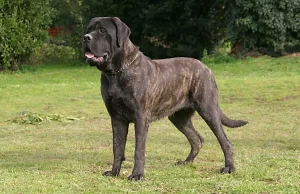

Mastiff
| Temperament | Exercise Needs | Training | Health | Lifespan | Potential Assertiveness |
|---|---|---|---|---|---|
| Gentle, Protective, Calm | Moderate | Moderate, can be stubborn but trainable | Prone to hip and elbow dysplasia, heart conditions, bloat | 6-10 years | Moderate |
The Mastiff, often referred to as the English Mastiff, is a large and powerful dog breed of British descent. Known for their size and strength, Mastiffs are among the heaviest breeds, with males weighing anywhere from 160 to 230 pounds or more.
History The history of the Mastiff goes back over 2,000 years, with the breed’s ancestors depicted in ancient art and literature. These dogs were used for war, protection, and entertainment in arena combat. The modern Mastiff was developed in England and was prized for its formidable appearance and protective instincts.
Temperament Despite their size and imposing appearance, Mastiffs are generally gentle and good-natured dogs. They are known for their loyalty and affectionate nature towards their families. They are protective and can be wary of strangers, but they are not typically aggressive without provocation.
Mastiffs are calm and quiet dogs who enjoy relaxing with their families. They are good with children and can get along well with other pets, although their size can be a challenge for very small pets or young children.
Exercise and Training While they are not as active as some breeds, Mastiffs still require regular exercise to keep them healthy and prevent obesity. A few short walks and a moderate play session each day are typically sufficient for this breed.
Training should start at a young age when the dog is still a manageable size. Mastiffs are intelligent and eager to please, which can make training relatively straightforward. They respond best to gentle, positive reinforcement techniques.
Health and Lifespan Mastiffs are prone to certain health conditions due to their size. These include hip and elbow dysplasia, heart conditions, and obesity. Proper diet and regular exercise can help manage their weight and prevent associated health problems.
The lifespan of a Mastiff is relatively short compared to smaller breeds, typically ranging from 6-10 years. However, with proper care and regular vet check-ups, many Mastiffs live longer, healthier lives.









